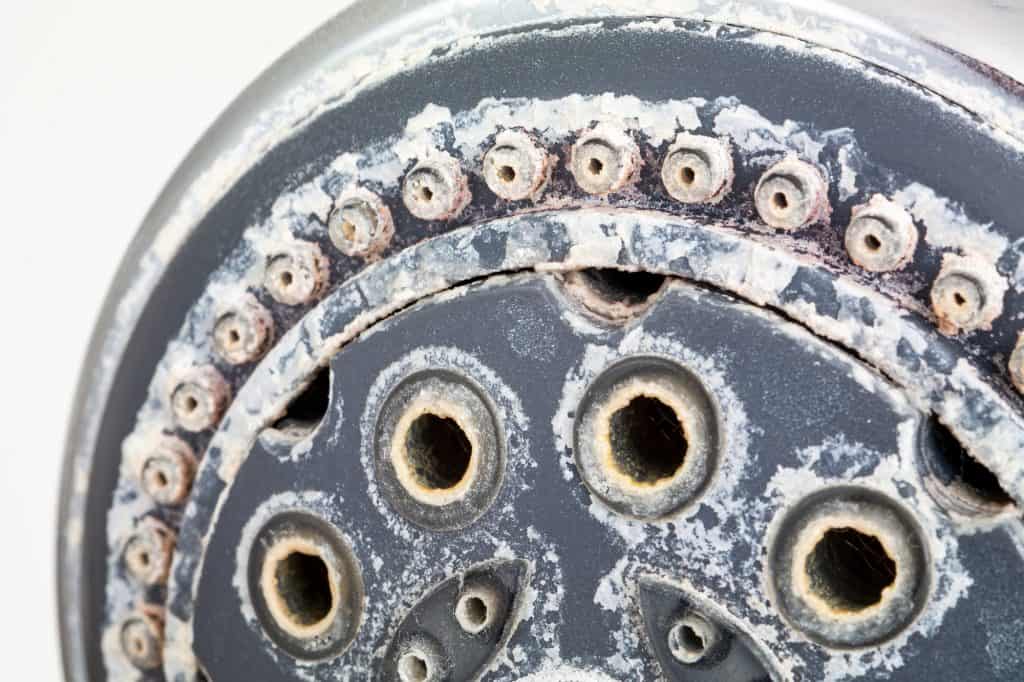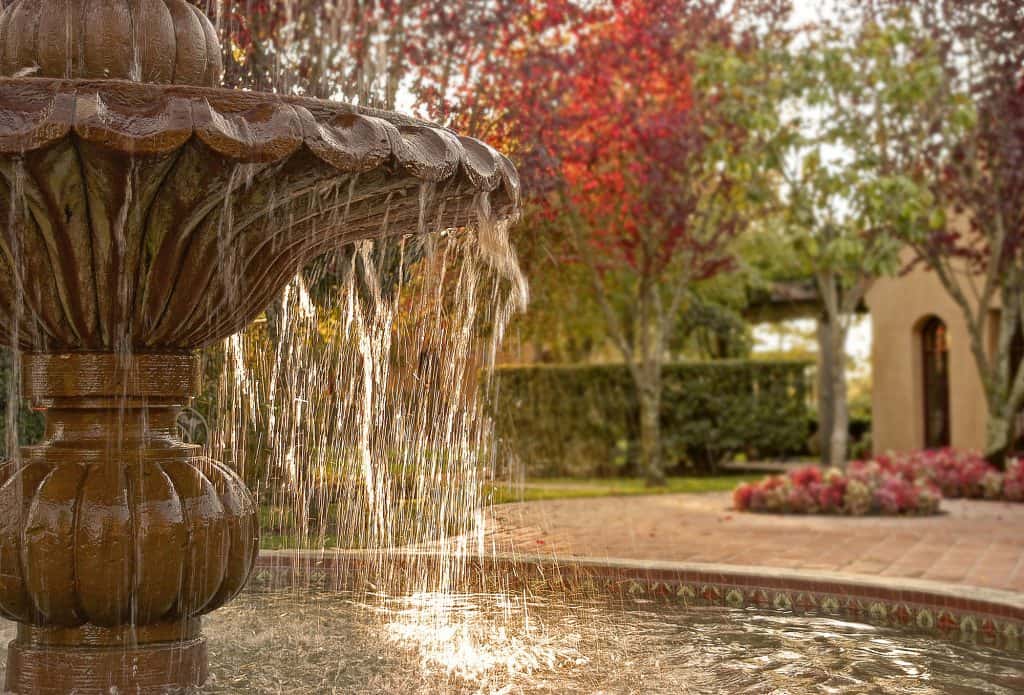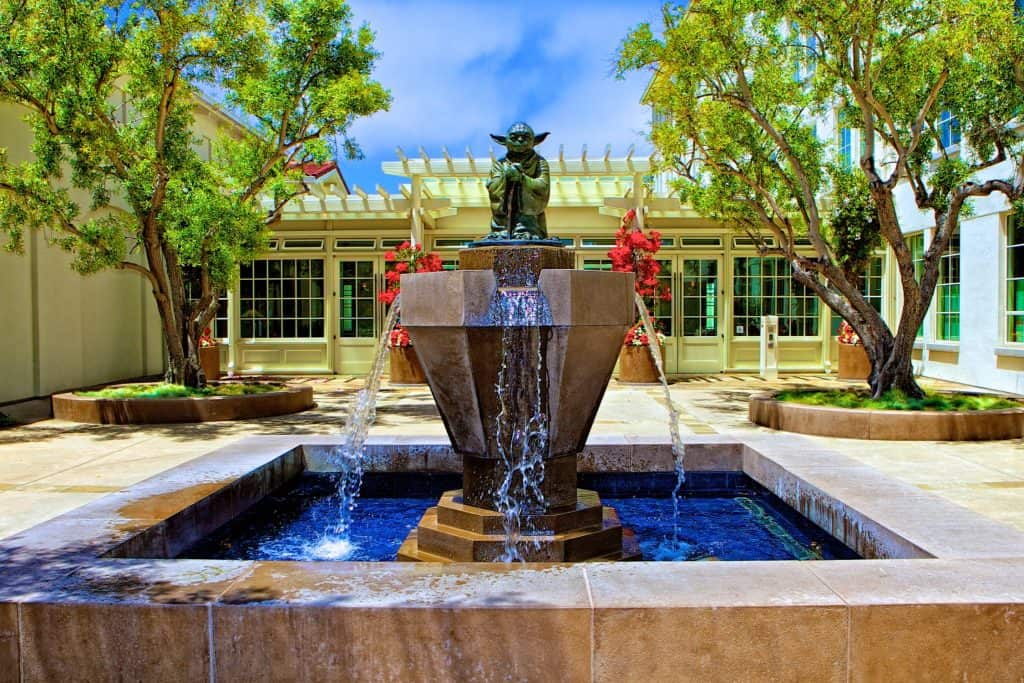To ensure that a fountain functions correctly, it must be routinely maintained and cared for. Calcium from chemicals contained in tap water can accumulate and become an eyesore on a beautiful fountain. But how do you remove calcium deposits from a fountain when it’s already formed?
You can remove calcium deposits from a fountain by scrubbing them with a vinegar solution. If the fountain is made from a durable material, you can use stronger substances like muriatic acid. Cleaning your fountain at least once every two months will prevent this mineral buildup from forming.
In this article, I’ll share with you a detailed guide on removing these unsightly blemishes from your fountain.
Following that, I’ve also highlighted some of the most common substances you can use to dissolve mineral buildup, a few tips & tricks to help you with fountain maintenance, and how often you should clean your water fixture to prevent the situation in the first place.

How to Remove the Mineral Build
Removing calcium deposits from your fountain is a straightforward process but a long one. As such, to ensure the cleaning goes smoothly, I highly encourage that you have everything you’ll need close to your hand.
Supplies
Here’s a quick list of things you’ll need when cleaning your fountain:
- Distilled water
- Vinegar
- A Toothbrush
- A non-abrasive sponge
Steps to Clean Your Water Fountain
Once you have everything in place, follow these steps to clean the fountain surfaces.
- Drain the water from the water fountain’s water pump by unplugging it. Tip the fountain upside down to empty the water. If the water feature is too big use the drain plug (if one exists) or the fountain pump to remove the water.
- On the stove, heat equal parts white vinegar and water until warm.
- Place the cleaning rag on the soiled area after dipping it in the vinegar.
- Allow 5-10 minutes for the vinegar to work its magic on the impacted areas.
- To remove stains, gently scrub the area with a soft-bristled brush. Resilient fountain materials like marble and cast stone, which can withstand severe cleaning, may be cleaned using a stiff nylon-bristle brush.
- Thoroughly clean the water fixture.
- Replace the water in your fountain with distilled water or water that has been disinfected with a fountain anti-scale treatment. This will help prevent further mineral stains from forming on your water fixture.

Substances Used To Dissolve Calcium Deposits
It is best to maintain the fountain by cleaning it regularly to stop additional calcium deposits. Otherwise, the accumulation might remain on the surface and cause corrosion. On the other hand, the stains can be removed in various methods.
Paper towels, toothbrushes, rags, protective eyewear, gloves, a spray bottle, vinegar, or similar non-toxic cleansers are all you’ll need. However, if you want to make the cleaning process a bit faster and more efficient, you can look towards some of the chemical substances I’ve listed below:
Lemon Juice
Lemon juice should be readily available at your local grocery store. But if it’s not, you can just get freshly squeezed lemon juice. Lemon juice contains citric acid, which is great for cleaning metal utensils, including faucets.
Vinegar blanc
White vinegar is excellent for removing stubborn water stains and salad dressings. This component is most likely already in your kitchen cupboard. To dissolve calcium buildups from the fixtures, soak a cloth with vinegar and put them over the calcium deposits.
CLR (Calcium, Lime, and Rust Remover)
CLR, also known as calcium lime remover, is another excellent product you should consider purchasing. It can be found at any home improvement store and at the cleaning aisle of many grocery stores.
Protec Cleanser
This fountain cleanser from Amazon.com (affiliate link) is a powerful, but mild cleaner that offers excellent prevention of white scale. It serves to prevent calcium deposits, erase stains on the material surface, and protect pumps from mineral accumulation when suitably diluted.
Muriatic acid:
Muriatic acid is technically a diluted solution of hydrochloric acid (HCl). It’s an excellent de-scaler because of its potency and can dissolve even the most extreme calcium builds.
Now, before you use any of these cleansers, I’d advise that you go through the manual that came with your outdoor water fixture. It should tell you what type of cleaners is best for your fountain and what you should avoid. Some fountains have unique finishes that are susceptible to harm.
Also, wear protective gear when handling these substances. Goggles and gloves are a must to protect your eyes and skin from accidental contact with any of these substances.

Fountain Maintenance: Tips and Tricks
Proper maintenance ensures that these unsightly nuisances on the fountain don’t worsen. Here are a few tips for maintaining your fountain:
- Replace the water to prevent the growth of algae. The water should be emptied and refilled once a month in smaller fountains. Algae development and calcium accumulation may be prevented by replacing the water.
- Treat the water. Treat tap and other hard water with a mineral deposit inhibitor to help prevent hard water mineral deposits. To minimize buildup and discoloration, make use of distilled water.
- Clean off mineral deposits to prevent buildup. Take a few minutes every time you empty the fountain water to clear off any locations where mineral buildup is occurring. Wipe away any accumulation with clean water and a quasi-sponge or towel. If you do this once a month, you can avoid significant buildups that are hard to remove.
- You may create your own cleaning solution. A mixture of equal parts muriatic acid and water can be used to remove more stubborn mineral deposits (only on a marble fountain). Scrub the stains off the fountain’s surface with a delicate nylon soft bristle brush immersed in the solution. The deposits may also be removed using equal amounts of white vinegar and water.
Common Questions
What Causes Calcium Deposits?
Generally, calcium deposits and hard water stains are caused by the hard water in your pipes at home. Without a hard water softener, the minerals from your tap water will wick onto the surface area of your water fixture. As the water dries, the minerals are left behind and accumulate.
The more evaporation that occurs, the more minerals will be left on the surface. With that in mind, consider figuring out why your fountain keeps losing water.
How Often Should You Clean Your Fountain?
You should clean your fountain monthly or at least once every three months. If the fountain is large and the water is clean, you can clean it less often. However, smaller fountains with less clean water flow require more frequent cleaning to prevent algae buildup or white scale accumulation.
Small Tabletop Fixtures
Small tabletop fountains generally have very little flow of water. As water remains relatively more stagnant, it increases the chance of algae formation and calcium deposits. This is why you should clean them at least once every month.
Larger Fixtures
Large walls and floor standing fountains may probably be cleaned every other month.
An essential thing to remember is that whether you have a backyard fountain, a tiny desktop fountain, or a DIY fountain wall, you should clean it regularly to keep it in good working order.
It’s also important to have a routine set for cleaning the fountain. You can do so by setting an alarm on your phone or marking a date on your wall calendar. You basically want to be reminded to clean your fountain before it gets too dirty, at which point it’ll become a painstaking chore.
Conclusion
Calcium deposits on a fountain occur as a result of hard water. Most tap water is generally hard water, which causes mineral deposits on the fountain. However, the steps to removing calcium deposits have been discussed in this article.
Also, maintenance is the key to making sure that the fountain looks as good as new. You can get further familiar with the maintenance tips by reading again.
Sources
- Carved Stone Creations: 4 Tips For Caring For Your Fountain Water
- Serenity Health: Water Fountain Cleaning Guide and Removing White Scale
- Soothing Company: Removing White Scale From Your Fountain
- Indoor Water Foundations: Preventing White Scale in Water Fountains
- Home Steady: How to Repair a 3 Tier Waterfall Fountain

